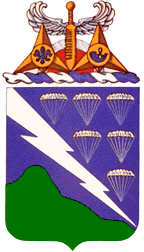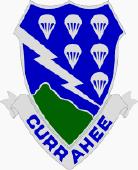506th Infantry Regiment, US Army: Difference between revisions
Knorrepoes (talk | contribs) m (Text replacement - "{{media}}↵" to "") |
Knorrepoes (talk | contribs) m (Text replacement - "{{us}}" to "") |
||
| Line 1: | Line 1: | ||
''' {{uc:{{PAGENAME}}}} ''' | ''' {{uc:{{PAGENAME}}}} ''' | ||
Revision as of 13:03, 27 December 2022
506TH INFANTRY REGIMENT, US ARMY
| (Coat of Arms) |
(Distinctive Unit Insignia) |
Official blazon
Shield: Azure, a lightning flash in bend throughout Argent, in chief, six parachutes, three, two and one of the last, in base a mountain issuant Proper.
Crest: On a wreath Argent and Azure, in front of a demi-plate bearing a demi-torteau surmounted overall in pale by a winged sword-breaker point to base Or wings elevated of the first, two caltraps conjoined gold that to the dexter bearing a fleur-de-lis of the second and that to the sinister a bugle horn of the like.
Motto: CURRAHEE (American Aboriginal, Cherokee Tongue: (Stands Alone).
Distinctive Unit Insignia. Description: A silver color metal and enamel device 1 1/4 inches (3.18cm) in height overall a shield blazoned: Azure, a lightning flash in bend throughout Argent, in chief, six parachutes, three, two and one of the last, in base a mountain issuant Proper. Attached below the shield a silver motto scroll inscribed "CURRAHEE" in blue letters.
Origin/meaning
Shield: The blue field is for the Infantry, the 506th's arm of the service. Thunderbolt indicates the regiment's particular threat and technique to attack: striking with speed, power, and surprise from the sky. Six parachutes represent the fact that the 506th was in the sixth parachute regiment activated in the U.S. Army, of which, the unit is proud. The green silhouette represents the Currahee Mountain -- the site of the regiment's activation (Taccoa, Ga.) -- and symbolizes the organization's strength, independence, and ability to stand alone for which paratroops are renowned. Crest: The winged sword-breaker represents airborne troops. The conjoined caltraps stand for the enemy line of defense behind which paratroopers are dropped. They are two in number in reference to the unit's two air assault landings. The fleur-de-lis is for the Normandy invasion and the bugle horn, from the arms of Eindhoven, Holland, refers to the organization's capture of that objective. The six large spikes of the caltraps stand for the unit's six decorations. The demi-roundel represents a section of the hub of a wheel. It stands for Bastogne, Begium, strategic crossroads of highways and railways. The hub, surmounted by the winged sword-breaker, commemorates the organization's heroic defense of Bastogne in the Battle of the Bulge.
The Coat of Arms and Distinctive Unit Insignia was originally approved for the 506th Parachute Infantry Regiment on 20 April 1943. They was amended on 23 August 1943 to correct the blazon. They was redesignated for the 506th Airborne Infantry Regiment on 18 March 1949. On 27 February 1958 they was redesignated for the 506th Infantry.
Literature: Pictures from Wikimedia Commons. Information form The Institute of Heradlry, US Army.

